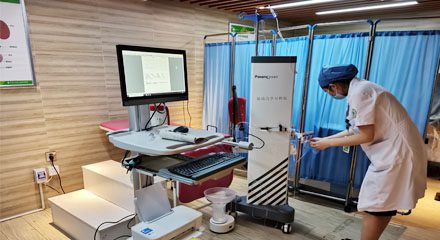Stress urinary incontinence (SUI) refers to the involuntary leakage of urine from the urethra when the abdominal pressure increases such as sneezing, coughing, laughing, or exercising. At present, the diagnosis and treatment of urinary incontinence are increasingly standardized at home and abroad. Urodynamics tests can not only type and diagnose urinary incontinence but also evaluate urinary incontinence, which has important clinical guidance value. This article is mainly to interpret the definition, principles, indications, equipment, and basic operation process of urodynamic examination, which is very helpful for clinicians to use urodynamic machines flexibly. As follows:

About urodynamics machine:
Based on the principle of fluid mechanics, the urodynamic machine uses electrophysiological methods and sensor technology to study the physiological processes of urine storage and urination and the inspection methods for dysfunction. The urodynamic examination is to show the main complaint of the patient’s lower urinary tract symptoms with images and numbers and provide a pathophysiological explanation for the patient’s pain.
The principle of urodynamics machine:
Urine storage is the main function of the bladder. The kidneys continuously produce urine during the storage period of the bladder and mainly gather here, and the urodynamic test simulates this process of the human body. Insert a double-lumen or triple-lumen urinary tube into the urethra, connect a water pump and a sensor respectively. The water pump is used to slowly pump normal saline into the bladder, and the sensor is used to detect the pressure in the bladder. The probe placed in the rectum mainly reflects the intra-abdominal pressure. Both are measured at the same time. Since the pressure of the bladder is produced by the pressure of the bladder detrusor and the abdominal pressure, the pressure of the bladder detrusor = the pressure of the bladder-the pressure of the abdomen. During the test, the patient should be asked about the patient’s feelings. When you feel the bladder has urine, it is the first sensation, and the feeling of urination is the first urgency. Besides, you will also do actions to increase abdominal pressure during the test, such as coughing, to observe the patient Whether there is leakage of urine, and record the abdominal pressure and bladder pressure when the urine leaks, and finally let the patient urinate, measure the urine flow rate and the pressure of the detrusor during urination. The above will generate a series of urodynamic values and graphs to reflect the patient’s urodynamics.
Indications of urodynamics machine:
(1) Those who have difficulty urinating;
(2) Those with abnormal residual urine volume;
(3) Suspected neurogenic bladder;
(4) Frequent urination, urgency, and exclusion of infection;
(5) Patients with SUI and frequent urination, urgency, and exclusion of infection at the same time;
(6) For patients with uterine prolapse or vaginal bulge, it is recommended to perform a urodynamic test after the prolapse is returned;
(7) If the anti-urinary incontinence surgery is not effective or needs to be operated on again, the urodynamic examination is required for evaluation;
(8) For patients with stress urinary incontinence (SUI), especially older SUI patients or preoperative SUI patients, a urodynamic examination is recommended;
Equipment needed for urodynamics machine:
The equipment required for the urodynamic analyzer mainly includes 1000 ml of normal saline, 1 lidocaine gel (to reduce the pain that may occur when inserting the urinary tube), and 1 three-chamber urinary tube (used to connect the pump and the sensor, Measure intravesical pressure and urethral pressure), a dedicated anal canal (used to connect a sensor to measure abdominal pressure) and a urodynamic tester.
The basic process of urodynamics machine:
Before the urodynamic analyzer, the patient is instructed to empty the bladder. The inspection process mainly includes 6 steps:
(1) Insert a special urine tube and anal tube, measure the residual urine, and connect the corresponding sensor and pump.
(2) Slowly inject normal saline into the bladder, and always ask the patient how he feels. At the same time, the machine measures the bladder pressure and abdominal pressure and calculates the detrusor pressure.
(3) When the bladder is half full, the patient is instructed to do a cough to measure abdominal pressure and leakage point pressure.
(4) Let the patient urinate, and record the urine flow rate and the pressure of the detrusor muscle at the same time.
(5) Measure urethral pressure, urethral closure pressure, etc.
(6) Analyze the graphics and conclude.
